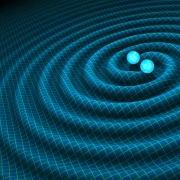Friday 4th October 2024 The Discovery of Gravitational Waves
Professor Mike Cruise
The image is an artist’s impression of gravitational waves generated by binary neutron stars.
Credit: R. Hurt/Caltech-JPL
In 1916 Albert Einstein predicted that his new theory of gravitation, now called General Relativity, included wave modes which could propagate in vacuum a little like electromagnetism. These modes- the “gravitational” waves- were predicted by Einstein to be so weak that they would “never be detected”.
Professor Mike Cruise
Mike Cruise has been active in Space Science for more than 50 years. He received degrees from University College London in 1968 and 1973 and went on to do research in X-Ray astronomy at the Mullard Space Science Laboratory using sounding rockets launched from Woomera, South Australia. In 1980 he was appointed to a lectureship at UCL and worked on Ariel VI and HIPPARCOS before leaving to join the Rutherford Appleton Laboratory in 1986. First as Group leader for Astrophysics and then Division Head and Associate Director of RAL, Mike was involved in the management of ROSAT, SOHO, Cluster and Spectrum RG. He served on many national and international space policy and review committees.
In 1995 Mike was appointed Professor of Astrophysics and Space Research at the University of Birmingham and set up the gravitational wave group at Birmingham in 1996. He led the Birmingham work on LISA Pathfinder in addition to continuing his own research on the interaction of gravitational waves and electromagnetic fields. Mike was appointed Head of Physics and Astronomy at Birmingham in 1997 and then Pro-Vice Chancellor for Research at the University in 2002.
Mike Cruise has chaired space policy committees in STFC, the UK Space Agency and ESA. He was appointed Professor Emeritus on his retirement from Birmingham in 2012 and has subsequently served as Treasurer and President of the Royal Astronomical Society.
Mike has written over 200 scientific papers and co-authored one book.

